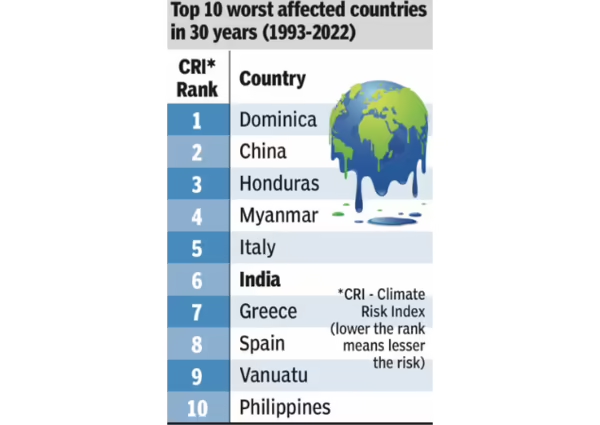1.Introduction
The Global Climate Risk Index (CRI) is published annually by Germanwatch, a Germany-based environmental think tank.
It assesses the impact of extreme weather events (such as storms, floods, and heatwaves) on countries worldwide.
The ranking reflects both the number of lives lost and economic losses due to climate-related disasters.
2. India’s Ranking in CRI 2025
Long-Term CRI (1995–2024): India ranked 9th, showing improvement from 8th last year.
Annual CRI 2024: India ranked 15th, improving from 10th in the previous year.
The report indicates progress in India’s climate resilience and disaster preparedness, though challenges persist.
3. Key Findings of the CRI 2025 Report
Period covered: 1995–2024 (30 years).
Extreme weather events in India: Around 430 events recorded.
Fatalities: Over 80,000 deaths.
Economic losses: Approximately USD 170 billion.
Release venue: The report was presented at the UN Climate Summit (COP30) in Belem, Brazil.
4. Global Context
Between 1995 and 2024, the world experienced:
Over 9,700 extreme weather events.
Around 832,000 deaths.
Economic losses exceeding USD 4.5 trillion.
Most affected countries (long-term):
Dominica, Myanmar, and Honduras.
Most affected in 2024:
St Vincent and the Grenadines, Grenada, and Chad.
Nearly 40% of the global population (about 3 billion people) live in the 11 most climate-affected nations, including India and China.
5. India’s Climate Challenges
India continues to face recurrent and severe weather disasters, including:
Cyclones: Hudhud (2014), Amphan (2020).
Floods: Uttarakhand floods (2013), Kerala floods (2018).
Heatwaves: 1998, 2002, 2003, and 2015.
Droughts and erratic monsoons affecting agriculture and livelihoods.
These recurring disasters highlight India’s high exposure and vulnerability to climate variability.
6. Reasons for India’s Improved Ranking
Enhanced early warning systems for cyclones and floods.
Better disaster preparedness and response mechanisms.
Implementation of climate adaptation and mitigation policies at national and state levels.
Community-based disaster management and focus on resilient infrastructure.
Strengthening of institutional mechanisms for rapid recovery and risk reduction.
7. Major Government Initiatives
National Action Plan on Climate Change (NAPCC) (2008):
Framework for 8 national missions (e.g., solar energy, sustainable agriculture, water, Himalayan ecosystem).
Coalition for Disaster Resilient Infrastructure (CDRI):
Launched by India in 2019 to promote climate-resilient infrastructure globally.
State Action Plans on Climate Change (SAPCCs):
Localised strategies aligned with NAPCC goals.
National Disaster Management Authority (NDMA):
Strengthening preparedness, early warning systems, and disaster response capacity.
Renewable Energy Expansion:
Target of 500 GW non-fossil fuel capacity by 2030 and achieving Net Zero by 2070.
8. Exam-Oriented Key Facts
| Aspect | Details |
|---|---|
| Report Name | Global Climate Risk Index (CRI) 2025 |
| Released By | Germanwatch (Germany-based NGO) |
| Released At | COP30, Belem, Brazil |
| India’s Rank (Long-Term) | 9th (1995–2024) |
| India’s Rank (2024 Annual) | 15th |
| Fatalities (India, 1995–2024) | 80,000+ |
| Economic Losses | ~USD 170 billion |
| Most Affected Countries (Long-Term) | Dominica, Myanmar, Honduras |
| Most Affected in 2024 | St Vincent & the Grenadines, Grenada, Chad |
9. Global and Policy Implications
Developing nations remain the most vulnerable to climate change despite contributing the least to emissions.
Even industrialised nations (like the US, France, Italy) appear in the top 30, showing that no country is immune.
Repetitive climate shocks in nations such as India, Haiti, and the Philippines hinder long-term recovery.
There is a pressing need for climate finance, technology transfer, and capacity-building support to developing countries.
10. The Road Ahead for India
Continue investing in climate-resilient infrastructure and nature-based solutions.
Strengthen local-level adaptation and early warning systems.
Enhance coordination between national and state agencies for disaster management.
Promote green financing, renewable energy, and sustainable agriculture.
Engage actively in global climate negotiations to ensure equitable climate finance and technology access.
11. Conclusion
India’s improved position in the Global Climate Risk Index 2025 reflects progress in resilience and policy action, yet underscores ongoing vulnerabilities to climate extremes. Sustained efforts in mitigation, adaptation, and sustainable development are crucial to safeguard livelihoods, ecosystems, and economic stability in the face of a warming planet.






